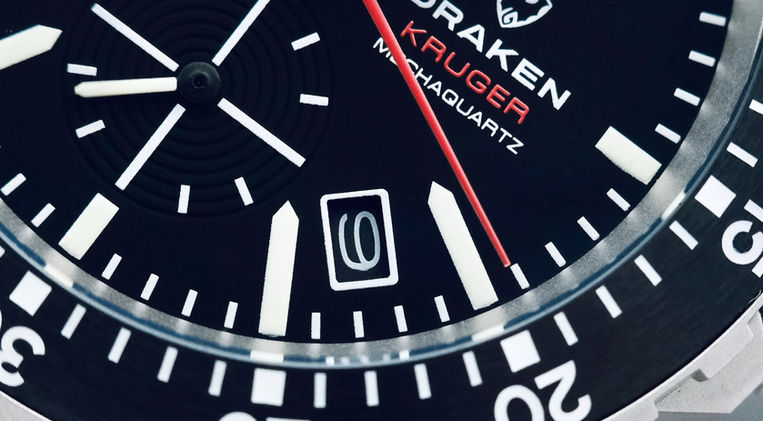Draken Kruger V2 Type “B” Titanium
Where’s My Rucksack?
July 10, 2025
Upon first discovery of the images and specifications of the upcoming Draken Kruger chronograph, my imagination went wild. Far into the past, to the times of the first explorers and purpose-driven tool watches. When brave folks needed to have reliable and practical timekeeping devices to accompany them on their journey. To the four corners of the earth, by sea, land, and air, to discover unchartered territories and draw the new frontiers of civilization. I do romanticize this time period as many of us do. And though these times were not idyllic and their bold enterprises not always anchored in honorable intentions, we are fascinated by the watches they wore on their wrists. And even though today fewer people go on such adventures, and fewer even find watches useful, brands nevertheless continue to make tough and reliable tool watches. And now we can all use them, abuse them, and build memories with them. They’re not only reserved for extraordinary adventures but made for everyday adventurers like you and I.
You won’t believe it but I’m a big fan of Draken. So much so that I’ve already covered four of its collections: the Tugela, Tugela GMT, Peregrine Version B, and Aoraki Mil-Spec. All built tough as nails. All ultra legible. All constituting extremely high value. And so my eyes wandered to the first generation Kruger for it appeared to make for the complete tool watch. The second version, the one we’re examining today, comes with new dial variants, new movements, and more refinements. I opted to look at the Seiko VK67-powered Type “B” for it has a 12-hour totalizer, something I’m highly curious about. On pre-order, this version on a bracelet will set you back $460.31 USD and $579.39 USD full retail. Pre-orders start tomorrow, July 11, 2025, at 9am NZST/11pm CET/5pm EST. Let me already tell you that we’re dealing with another great deal of a tool watch and so I estimate that, by the end of this review, you will have already pulled your credit card out of your wallet.

Specifications
Tool watches from the 1950s—when the first horological-equipped major human exploits were initiated—were very different from what they are today. They used to be elegant, small, and built to resist variations in temperatures, shocks, and humidity. Tool watches from today do the latter and more, having more precise movements, higher resistance to shock, magnetism, water, dust. And they look very different too—more purpose-driven, tougher, stealthier, and under-the-radar from a shiny perspective, not from a dimension one. It seems that nowadays watches must be larger and thicker in order to be sturdier and more functional. At least that’s as far as my basic understanding of mechanics goes. Draken doesn’t make small watches, neither does it make large watches. It makes appropriately-sized watches for their intended purpose and matching specifications. Add more functionality and water resistance, and the diameter stretches horizontally and vertically by a few millimeters. Though the Kruger with the Seiko VK67 is surprisingly nimble on the wrist.

Because the case and bracelet are made of grade 2 titanium, reinforced to 1,200Hv on Vicker’s Hardening Scale, and measures 44mm in diameter, 49.5mm lug-to-lug, 12.45mm thick (for the mecaquartz version, 15.6mm for the automatic one,) and has 22mm lug width. Sized to my 6.50”/16.5cm wrist, the Kruger weighs 124g on the bracelet which is really good. The case screws-down, so does the crown, for 100 meters of water resistance. The chronograph pushers don’t, however, which has no impact on the depth rating. The crystal is a double-domed piece of sapphire with inner and outer anti-reflective coating for superlative daytime legibility. The hands, printed markers, and bezel markings are lumed and glow green and blue for nighttime readability. (Draken is notorious for being generous with lume.) The bezel is bidirectional, has 60 precise clicks, no backplay, and aligns perfectly which is always a nice, though not always guaranteed, bonus. The bezel insert is made of radially brushed ceramic for extra resistance to scratches and nicks.

The machine powering the Type B version of the Kruger is therefore the Seiko VK67 mecaquartz chronograph caliber. It has a stated accuracy of +/- 20 seconds per month (oh glory of these movements) and a battery life of +/- three years. It has a triple register layout with the running seconds at the six, a 12-hour totalizer at the nine, a 60-minute totalizer at the twelve, and a date aperture at the 4:30. The latter has a color-matched date disc, numerals printed in white, and is neatly tucked away and legible. The bracelet is equally mechanically thought-through for it is made of reinforced grade 2 titanium, a stainless steel clasp with a built-in on-the-fly micro-adjustment mechanism of the ratcheting variety with four positions of adjustments. The links are screwed together and fully articulate. The end-links are of the female type and equipped with quick-release spring-bars, and further accompanied by drilled lug holes. There was a lot to be said about the bracelet!

Design
When I first saw images of the Draken Kruger, then glanced at the spec sheet, and then received a press sample and strapped it to my wrist, a thought came about: “Where is my rucksack? I’m ready to go.” Draken created the Kruger to pay tribute to the rangers who patrol the rugged and hostile environments of the Kruger National Park in South Africa and protect the numerous endangered species of animals that live inside and around it. Especially the White Rhinoceros. (Take a look at the case-back and you will make the connection.) Not that the rangers wear Draken watches but a portion from each watch sold goes to support their conservation work. So the watch was built with the thought of being able and capable to handle such terrains and lifestyles. Which means it’s more than appropriate for any adventure you’ll embark on at home or abroad doing touristy things or nonprofit work. And so the Kruger was designed to follow that intended purpose.

The case and bracelet of the Kruger are therefore made of grade 2 titanium which is light and comes with a matte finish which doesn’t reflect light. I assume the nature of this material is equally useful in a national park as it would be on the battlefield, and though I don’t often find myself in the first situation and never will in the second—though no one really knows—I do prefer this type of case treatment for it endows the watch with a superb under-the-radar quality. The same can be said of the brushed ceramic insert for the same reasons, and of the deep and matte black dial. Notice how there isn’t a bit of shine on the Kruger, neither on case nor on the dial. The former was designed to command the least amount of visual presence as possible, for being rather flat, slab-sided, and for the bezel covers most of it. The 6.7mm crown is large but blends in within its stubby crown guards, and the chronograph pushers are short and flat.

I’ve generally stayed away from full-fledged chronographs because their dials often appear visually too busy. With the exceptions of a few utilitarian ones of course. The Kruger has a lot of things to communicate on various levels and all is neatly organized. The Type B—with three sub-registers and baton markers—appears less busy than the Type A—with two sub-registers and Arabic numerals for the markers. At least to me. The hour and minute hands are of a modified Alpha design where the wider part is higher on the latter, with white surrounds and black bases. The chronograph hand is painted red to stand out from the time-telling functionality and its color is answered by the model name printed at the three. The running seconds sub-register has a paired-down design with aviator-like cross-hairs and small dashes for the five-minute increments. The 12-hour and 60-minute sub-registers are fully graduated and easy to read, and all three have lumed hands and deep radial finishes.

Moreover, the pencil-shaped printed hour markers have a creamy color also found on the hour and minute hands because they are made of C3 SuperLuminova, whilst the markings on the bezel appear white because they are entirely made of BGW9. So there is a contrast of colors during the day and at night which creates a subtle visual hierarchy during the former and a brilliant spectacle during the latter. All printed information on the dial is crisp and flawless and perfectly flows onto the grooves of the sub-registers and shallowly incised bezel markings. Not only is the dial well organized but the quality of manufacturing—which is high and unsurprisingly good for Draken—aids in making all of it legible. Which is why, even before I knew why, I was going to have a good time studying the Draken Kruger up close. I’d say that the design and manufacturing are excellent for the asking prices of $460.31/$579.39 USD.

The Heart of the Matter
There are two camps for tool watches. One the one side, the luxury camp with the high end movements, revolutionary case materials, legacy, and matching retails prices that total in the thousands and more. On the other side, the get-shit-done camp with affordable and robust calibers, simple but tough case materials, nascent heritage, and matching reasonable retail prices that generally fly under the $1,000-mark. The former camp is for those who generally like the idea of adventure near or far. The latter camp is for those who actually go on adventures near or far. To me the Draken Kruger Type B with the VK67 caliber is one of these watches that epitomize the straightforward beauty of hardcore tool watches we can all afford and use, abuse, and build memories with. And that could be said also about the automatic versions of the Kruger which, however, retail for $1,454.65 on pre-order and $1,818.31 USD full retail on the titanium bracelet. But even then, you’re guaranteed to have a proper tool watch with a distinct personality. And we like that.

Conclusion
The Draken Kruger comes in a total of nine versions with two types of case materials, three calibers (Seiko VK63 or VK67 for the mecaquartz versions, ETA/Valjoux 7750 for the automatic version,) and three dial configurations. Prices start at $387.55 USD for the mecaquartz titanium version on a canvas strap on the lower end of the spectrum (on pre-order) and reach $1,818.31 for the automatic titanium version on matching titanium bracelet on the higher end of the spectrum (full-retail.) Whichever version you go for and at whatever moment you put your order in, you won’t regret having pulled the trigger on this mad machine of utilitarian horology. As Draken describes it, the Kruger is a lightweight tactical chronograph and I for one wholeheartedly agree with that statement.
Thanks for reading.








































